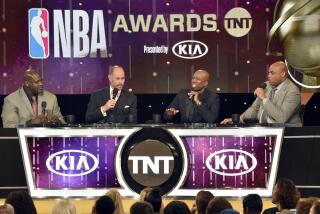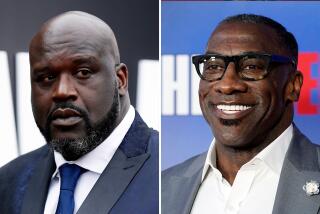These Days, O’Neal Is the Big Question
- Share via
Until recently, an enlarged photograph of Shaquille O’Neal and Kobe Bryant in happier times hung at the forefront of the hallway gallery leading to the gym in the Laker practice facility. They were wearing leather Laker varsity jackets and sitting amid their three NBA championship trophies, beaming.
They were so happy, it would later become wrenching to look at and remember how simple Bryant’s world was then, and the team’s -- and how recently. That’s probably why this spring the photo was taken down and replaced.
Two years after the Lakers rolled over the New Jersey Nets for title No. 3, nothing is simple and the unthinkable is routine.
Among insiders, Bryant is presumed to be leaning toward leaving, and his strained relationship with O’Neal is said to be one of the reasons. The organization doesn’t know which way to turn, hoping against hope it won’t have to turn at all.
But if the Lakers must choose ...
Once, it was a no-brainer. Bryant was special and breathtaking, but O’Neal was the most dominant player of his and, perhaps, any era.
Now, the choice, like everything else the Lakers face, is thorny and perilous. Worse, they may not even have a choice.
Bryant is more dominant than he ever was, even in a series in which his shot isn’t falling, and a situation in which every move is examined for motive.
O’Neal isn’t as dominant as he was, smarter at 32 but without the explosiveness he had at 27. He’s still the game’s best center, but the days in which he seemed to be a separate species are winding down.
In O’Neal’s all-but-undisputed-MDE (Most Dominant Ever -- his term) days, sages as revered as Pete Newell and Jack Ramsay put him in a class of his own.
That was among the all-time greats, with Bill Russell, Wilt Chamberlain and Kareem Abdul-Jabbar.
Among current players, it was an easy call. There was O’Neal, and then there was ... no one.
If he was the standard at center, other great big men, such as Tim Duncan, decided they must be power forwards. Indiana President Donnie Walsh, watching the teams come out for the opening tip in the 2000 Finals, was dismayed to find he couldn’t even see his center, 7-4 Rik Smits, who was standing behind O’Neal.
Now there’s another giant on the horizon, younger, less accomplished, but still big enough and tough enough to pose O’Neal’s first challenge since the early ‘90s when he was the young behemoth and Hakeem Olajuwon, David Robinson and Patrick Ewing were in their primes.
This is Yao Ming, 23 years old, 7 feet 6, 310 pounds and up to the challenge, far ahead of schedule, even if it’s still too early to topple the king.
“He’s getting tougher,” Houston Rocket teammate Jim Jackson said of Yao. “He’s got a long way to go to be tough, but he’s getting tougher and you can’t expect that change to happen overnight. I mean, it just doesn’t happen that way, as much as we want it to.”
Yao is an international-style, face-the-basket forward who can shoot and pass, learning to play inside in the NBA, where it’s all power and leverage. If he’s progressing, Yao will still often throw the ball out, even when he’s in deep, when O’Neal bumps him.
However, something must be getting lost in translation, such as the Rockets’ desperation for Yao to make up for everything else they lack at this level.
After four games, O’Neal has outscored Yao by only 69-65 and outrebounded him, 47-32. O’Neal is shooting 53%, Yao 48%.
It’s still an edge for O’Neal, but it has been a long time since anyone came that close, and it has never happened since he became a Laker in 1996.
O’Neal bristles that anyone would even compare them, noting the help Yao gets. In fact, Yao guards O’Neal only until he gets in foul trouble, which is usually two minutes into the game, when Kelvin Cato is switched over.
However, the fact the numbers are even close is significant and there are more issues, such as conditioning and free-throw shooting.
O’Neal now tends toward fast starts and slow finishes. Coach Phil Jackson has twice suggested that he tired in this series, as Sunday when Jackson said, “I was on him about playing defense the way we wanted him to play. He wasn’t active enough. But he pulled it out and got active defensively and got some rebounds. I was pleased the way he rallied at the end.”
O’Neal, of course, has his own theory, as he explained after Game 1:
“I wouldn’t say I was tired. I would say I was beat up. I’m the only guy in the history of the game that has to play against three, four guys every night. If I don’t get fatigued, they should check me for smoking crack.”
O’Neal will never lack defenders or theories. He has another problem at the free-throw line, where he has fallen apart and is trying to reassemble himself.
Meanwhile, the Rockets foul him whenever he looks at the hoop in crunch time, so even if he gets the ball the Lakers don’t get much to show for it.
Of course, the Lakers have always felt the supportive approach works best.
“I always felt, the more you focus on it, the more it becomes an issue, the more difficult it is for him,” Jackson said last week, “so I try to let him just sort that out and he’s been able to find his way through those things in the course of the years.”
Imagine Jackson’s delight when in the course of letting him sort things out, he looked up to see O’Neal had backed a foot or two off the line and was now firing from 16 or 17 feet.
This violates several principles of basketball and physics. First, shorter is easier. Second, longer is a lot harder when your shot is as flat as O’Neal’s.
Third, O’Neal may not even be taking the same shot every game, or quarter. There are times when he looks as if he’s a foot behind the line, and others when it looks like more than that.
Jackson, feeling less supportive Monday with O’Neal at 13 for 42 in the series and 24 for his last 80 overall, said such free-throw shooting was “right in the garbage.”
“It’s awful,” he added. “I’ve just told him time and again, we cannot survive in these playoffs if he doesn’t get his free-throw shooting in order.”
One way or another, things will be sorted out and then it will be the Lakers’ turn to sort things out.
Despite media speculation, Bryant isn’t sending back-channel ultimatums about what he needs to stay. The organization isn’t even a factor in what he’ll do. He’s not looking for ways to remain a Laker; he’s wondering why he would want to.
Insiders say the reason the Lakers broke off negotiations with Jackson, and announced it, was to signal to Bryant they would choose him over Phil, if it came to that.
The problem for the organization is, it may not matter.
Of course, that’s a dilemma for June and July. At present, they’re just trying to survive April and May.
More to Read
All things Lakers, all the time.
Get all the Lakers news you need in Dan Woike's weekly newsletter.
You may occasionally receive promotional content from the Los Angeles Times.






